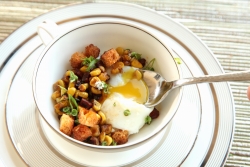Poached Egg


A perfect poached egg should have a distinct layer of egg white around the exterior that is firmer than the rest of the egg. A sort of skin, if you will. Similarly, soft boiled eggs should have whites that are firm around the edges—firm enough that they hold their shape when you peel the eggs—but yolks that are completely liquid. How do we achieve these effects?
With poached eggs, it’s simple. Once we've gotten our tender-and-barely-set 145°F 45-minute eggs, the only thing we need to do to convert them into bona-fide poached eggs is to, well, poach them. This is a technique I first saw employed by Nick Anderer, chef at New York's Maialino. You simply crack the eggs and tip them into a bowl, then slip them into a pot of barely simmering water just until a skin forms around the exterior. You wind up with foolproof poached eggs with an internal texture that strikes that perfect balance between runny and rich.
Author
J. Kenji López-Alt
J. Kenji López-Alt is the Managing Culinary Director of Serious Eats, author of the James Beard Award-nominated column The Food Lab, and a columnist for Cooking Light. He lives in San Francisco. A New York native, Kenji cut his cooking chops the old-fashioned way by working his way up through the ranks of some of Boston's finest restaurants. With an education in science and engineering and as a former Senior Editor at Cook's Illustrated and America's Test Kitchen, Kenji is fascinated by the ways in which understanding the science of every day cooking can help improve even simple foods. He earned a James Beard award for his first book, The Food Lab: Better Home Cooking Through Science, which he released in September 2016. It is available for purchase from Amazon and Barnes & Noble.
Prep Time: 00:00
Recipe Time: 00:45
Temperature :
145F / 62.8C
Ingredients
Directions
- Preheat the Precision Cooker to 145°F / 62.8ºC. Once the water has reached temperature, carefully add the eggs to the water bath and cook for 45 minutes.
Finishing Steps - Poaching
- After the egg has cooked for 45 mins, you will need to poach the egg. First, heat a pot of water to just below simmering.
- Next, crack and peel the egg. To remove the egg from the shell, crack the large end of the shell on a flat surface, then carefully peel away a window with your fingertips while still holding the egg with your other hand. The watery, loose white will begin to drip out. This is ok. You won't need that part.
- Once you've peeled half of the egg, gently flip the egg out of the rest of the shell and into a bowl. Out should come a perfectly egg-shaped object consisting of the gelled soft white and yolk, surrounded by the watery, barely-set loose white. Our goal is to leave that loose white behind.
- Separate the loose white from the rest of the egg. To do this, I use a perforated spoon to carefully lift the eggs before dumping the loose whites out.
- From here, the egg gets slipped into the pot of water that is just below a simmer. It should immediately start to set around the outside.
- Swirl the water in the pan occasionally to make sure the eggs aren'y sticking to the bottom and becoming flat on one side. Since the eggs are already mostly set, this is not as big a problem as it is when poaching raw eggs. The eggs need only about a minute to develop a skin.
- Finally, fish out the egg with the perforated spoon. What you end up with is the platonic ideal of a poached egg. Ivory white and opaque with a perfect egg shape and a tender outer skin that just barely holds in the liquid contents inside. Your eggs benedict will never be the same.

